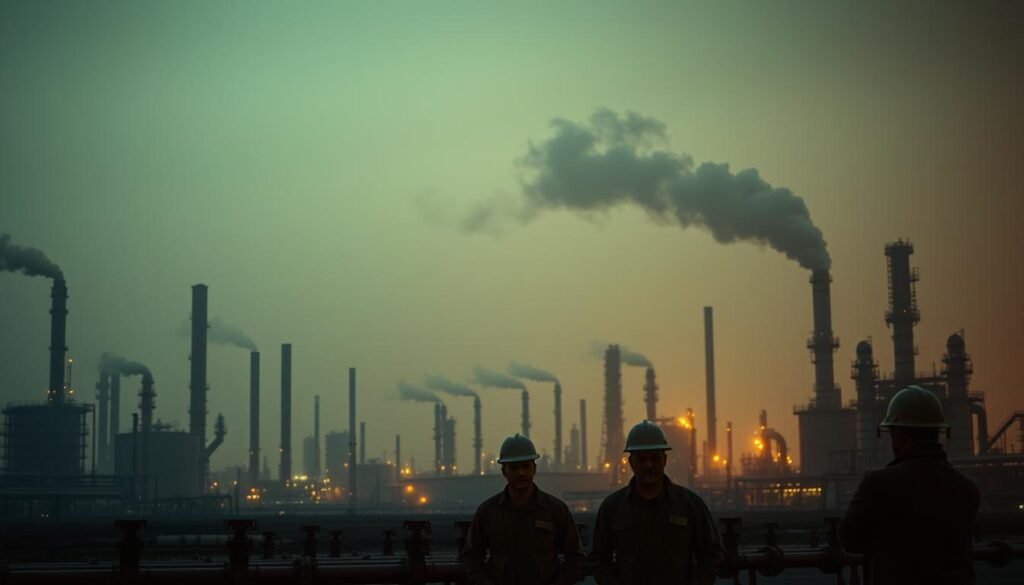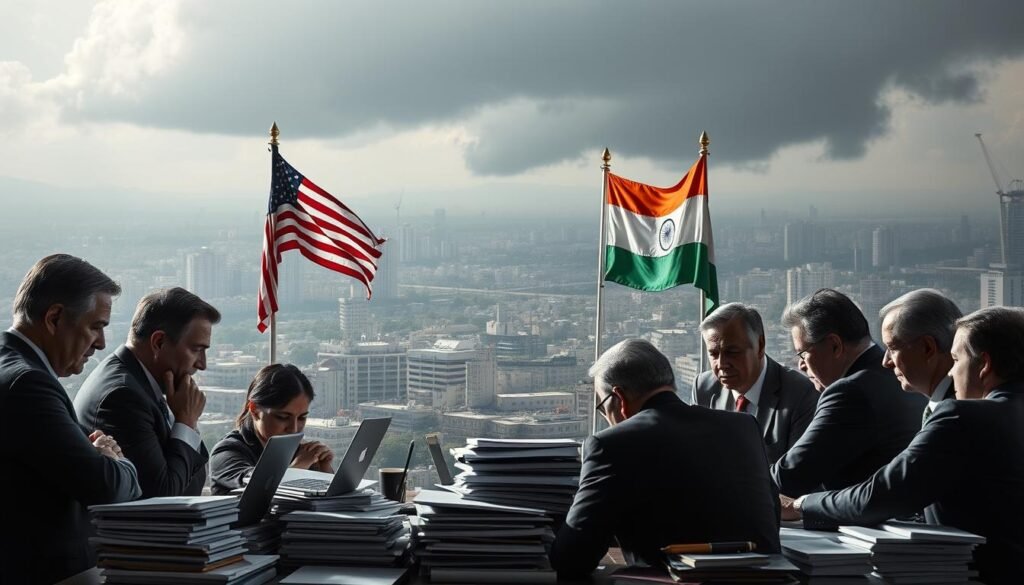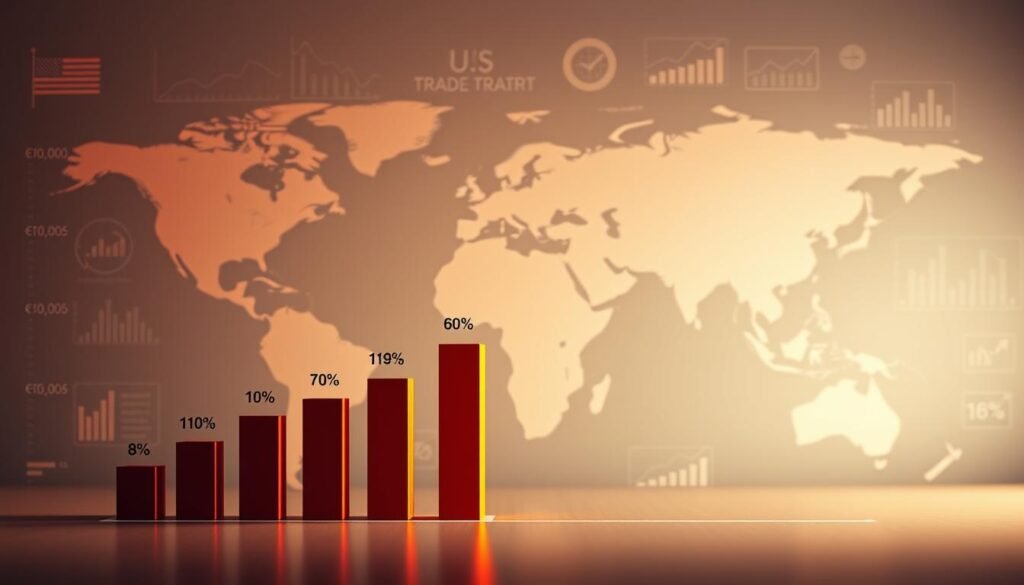Trump’s New Tariffs on India: A Deeper Look at the 25% Rate and “Penalty”
India trades $87.7 billion with the United States each year. It’s the ninth-largest trading partner. Now, President Donald Trump is introducing new tariffs on imports from India.
On Wednesday, the Trump administration announced a 25% tariff on Indian goods starting August 1. President Trump made this announcement on Truth Social. He called India a friend but criticized their trade practices.
Trump’s tariff on India is slightly lower than the 26% he initially mentioned. He was considering between 20% and 25% before deciding. An extra penalty will be added for India’s Russian military and energy imports.
The White House hasn’t shared details on the penalty structure yet. India’s Commerce Ministry said it’s studying the impact of these changes. This move changes the economic relationship between the two countries, despite their strong diplomatic ties.
Key Takeaways
- President Trump announces 25% tariffs on Indian imports effective August 1
- Additional penalties will target India’s Russian military and energy purchases
- The rate dropped slightly from an initial 26% announcement
- India-US bilateral trade totals $87.7 billion annually
- Trump cites India’s high tariffs and trade barriers as justification
- India’s Commerce Ministry is studying the policy implications
Understanding Trump’s New Tariff on India
President Trump has made a big change in US trade policy towards India. The new 25% tariff is a big deal, showing a careful change from earlier plans. It’s not just about numbers; it’s about fairness and India’s global partnerships.
The August 1st Implementation Date
The new tariffs on Indian exports to America start on August 1, 2025. This move is part of a bigger change in US trade policy. Companies exporting things like medicines, clothes, and gadgets to the US need to rethink their plans fast.
The summer start gives them time to get ready for the economic impact of tariffs. But the pressure is on to make quick deals.
From 26% to 25%: The Rate Evolution
The tariff rate changed from 26% to 25% after talks. Trump first said 26% on “liberation day,” but then it was 25%. This small change shows the administration’s focus on India’s trade.
Additional Penalties Beyond the Base Rate
There are extra penalties for India’s Russian oil and military buys. Trump said India would face “25%, PLUS A PENALTY.” The details will come from Trade Representative Jamieson Greer.
Analysts think these extra tariffs could hit 10% of India’s exports in the third quarter. This makes the trade war with India even more intense.
Is India a “Tariff King”? Debunking the Claims and Examining the Trade Deficit
President Trump called India a country with high tariffs. He said it has tough trade barriers. His Truth Social posts shouted: “WE HAVE A MASSIVE TRADE DEFICIT WITH INDIA!!!” But are these claims true?
Let’s look at the numbers. The U.S. Census Bureau says our trade gap with India was $45.8 billion in 2024. Total trade between us was $129.2 billion. This deficit is real, but what does it mean?
India’s average tariff rates tell a different story from Trump’s words:
| Country | Average Applied Tariff Rate | Trade Balance with US (2024) |
|---|---|---|
| India | 17.6% | -$45.8 billion |
| Brazil | 13.5% | -$21.3 billion |
| Argentina | 13.7% | -$4.2 billion |
| South Korea | 13.1% | -$51.3 billion |
| China | 7.5% | -$279.4 billion |
Economists say buying goods from countries with lower labour costs helps American shoppers save money. But would American workers take low-skilled jobs to make these goods? The answer to Is India a ‘tariff king”? debunking the claims and examining the trade deficit is more complex than it seems.
Trump’s Justification for the New Trade Policy
The Trump administration’s trade policy towards India is based on several key points. President Trump has often criticized India’s trade practices. He believes these criticisms justify the new 25% tariff rate.
His administration sees these tariffs as necessary to protect American economic interests. They also aim to address what they see as unfair trade practices.
India’s “Highest in the World” Tariffs Claim
President Trump says India’s import duties are “far too high, among the highest in the World.” This is a key argument for his trade policy. While India does have higher tariffs than many countries, the situation is more complex than Trump’s words suggest.
| Country | Average Tariff Rate | Key Products |
|---|---|---|
| India | 13.8% | Electronics, vehicles |
| China | 9.8% | Technology, machinery |
| Brazil | 10.2% | Industrial goods |
| United States | 3.5% | Various imports |
Non-Monetary Trade Barriers Concerns
Trump has also criticized India’s “most strenuous and obnoxious non-monetary Trade Barriers.” These include complex regulations, licensing restrictions, and bureaucratic hurdles. American companies face these challenges when trying to enter the Indian market.
The administration believes these barriers add to the obstacles beyond traditional tariffs.
The $45.8 Billion Trade Imbalance
The $45.8 billion trade deficit with India is a major concern. Trump sees this deficit as a threat to national security. He believes tariffs can help offset budget deficits from recent tax cuts and create jobs.
Economists, though, warn that these trade tensions could slow U.S. growth and increase inflation. Costs may rise for American businesses and consumers.
The Geopolitical Chess Match: Why Russia’s Shadow Looms Over US-India Trade Talks
The proposed tariffs on India are more than just trade issues. They involve a complex web of relationships, including India’s ties with Russia. Trump has criticized India for its dealings with Moscow, which have heightened global tensions.
India’s Military Equipment Purchases from Russia
India depends on Russian military tech. It has S-400 missile systems, Sukhoi jets, and T-90 tanks. These are key to India’s defence, showing a long-standing partnership with Russia.
Trump sees this as a problem. He believes India should buy more from the West, not Russia. This is part of a broader effort to isolate Moscow.
Energy Imports and the Ukraine Conflict
Russia supplies about 37% of India’s oil. India gets this oil at a discount, saving billions. This contradicts Western sanctions on Russia.
India must weigh its energy needs against possible US tariffs. This is a tough spot for India in the global chess game.
Secondary Sanctions Threat
Trump has threatened 100% tariffs on countries buying Russian oil. This includes India, China, Brazil, and others. It’s a high-stakes move that could hurt India’s economy.
India faces a hard choice. It must decide between cheap Russian oil and access to American markets.
Most Vulnerable Indian Export Sectors
The proposed 25% tariff could harm several key sectors of indian exports to America. These sectors are worth tens of billions of dollars each year. The impact could change India’s export scene for many years.
Electronics manufacturing is very vulnerable. India just became the top smartphone supplier to Americans. Big names like Apple have set up factories in India. The economic impact of tariffs might make them rethink their plans.
Pharmaceutical exports also face big challenges. Generic drugs from India save Americans billions on healthcare. These drugs are worth about $8 billion a year. Tariffs could raise prices, hurting millions who need affordable medicines.
The gems and jewellery industry is worried too. They send over $10 billion worth of products to the U.S. each year. Textile makers for big retailers like Walmart and Gap could lose long-term deals.
Energy companies have a special problem in this trade war with India. Companies like Indian Oil Corporation rely on Russian oil. They turn this oil into products for American markets. Tariffs and sanctions hit them hard.
Impact on Indian Refineries and Energy Companies

India’s energy sector is facing a big challenge. Trump’s new tariff on India could change how the country imports oil. Major refineries are worried about how this will affect their work and profits.
This change could also change India’s plan for energy security.
Government-Owned Refineries Under Pressure
State-run companies like Indian Oil Corporation, Bharat Petroleum, and Hindustan Petroleum are in trouble. They handle millions of barrels every day. They need cheap oil to stay profitable.
The tariffs could make oil more expensive. This could hurt their profits.
Reliance Industries’ Russian Oil Agreements
Reliance Industries is India’s biggest private refiner. They have big deals to buy oil from Russia this year. They plan to buy up to 500,000 barrels per day.
This makes them the biggest buyer of Russian oil in India. They get about 37% of India’s oil imports.
Cost Implications for India’s Energy Security
The numbers show the big risk:
| Impact Area | Current Scenario | Potential Change |
|---|---|---|
| Russian Oil Share | 37% of imports | Forced reduction |
| Price Advantage | Below market rates | 15-20% increase |
| Consumer Fuel Costs | Stable | Likely to rise |
If they can’t get cheap Russian oil, they’ll have to buy more expensive oil. This could make fuel more expensive for people. It could also hurt the refineries’ profits.
Electronics Manufacturing and Apple’s India Strategy
India is now a big player in making smartphones, surpassing China as the top supplier to the US. This change is big for us-india trade relations. Apple’s move to make iPhones in India was key to this shift.
The economic impact of tariffs on this field could be huge. Bloomberg Intelligence says Apple might struggle if tariffs hit 25%. This could make Apple rethink its plans in India.
The Trump administration didn’t put tariffs on smartphones and computers at first. But they started looking into tech sectors under Section 232 of the Trade Expansion Act. This is about the security risks of importing semiconductors.
If iPhones are included in this, Apple will have tough choices. They might have to lower costs with suppliers in India or move production elsewhere. This would impact indian exports to America in electronics, which have grown a lot.
India’s electronics manufacturing sector has millions of jobs and attracts billions in foreign investment. If Apple’s plans change, it will affect many. This includes suppliers, workers, and logistics companies all over the country.
Pharmaceutical Industry Facing Unprecedented Challenges

India’s pharmaceutical sector is at a critical point. Proposed 25% tariffs could change how affordable healthcare is in America. This could disrupt a supply chain vital to millions of US patients who need affordable generic meds.
The trade war with India might change how Americans get their prescription drugs. This could have big effects on their health.
Generic Drug Exports Worth $8 Billion at Risk
Indian pharmaceutical companies export about $8 billion worth of generic meds to the US each year. This trade didn’t start overnight. It took decades of work in quality and following the rules.
The economic impact of tariffs on these exports could affect healthcare in both countries.
Major Indian Pharma Companies’ US Revenue Exposure
Top Indian pharmaceutical companies face big challenges from new trade policies. Firms like Sun Pharmaceutical Industries, Dr. Reddy’s Laboratories, and Cipla get over 30% of their revenue from the US. In 2022, Indian makers filled 40% of all US prescriptions.
This shows how important they are to American healthcare.
Impact on US Healthcare Cost Savings
Indian generic drugs saved the US healthcare system about $220 billion in 2022. Over ten years, these savings hit $1.3 trillion. If tariffs raise generic drug prices, insurance and patient costs could go up.
Gems, Jewellery, and Textile Sectors Under Threat
A 25% tariff could hurt two key Indian export sectors. The gems and jewellery industry sends over $10 billion to the U.S. each year. The textile industry, also vital, faces similar threats that could change long-standing trade ties.
Industry leaders are worried about the impacts and consequences on jobs and supply chains. The Gem and Jewellery Export Promotion Council fears tariffs will have a ripple effect:
- Inflated costs for American consumers
- Delayed shipments are disrupting holiday sales
- Distorted pricing affecting competitiveness
- Pressure on manufacturing units employing millions
Big textile companies are facing big challenges in the trade war with India. Vardhman Textiles, for example, is seeing fewer orders because of tariff worries. Other companies like Welspun Living, Indo Count Industries, and Arvind Fashions are also struggling. American buyers are looking for suppliers with lower tariffs.
The Confederation of Indian Textile Industry says these measures will test exporters’ strength like never before. Small artisans making handcrafted jewellery and traditional textiles are hit hardest. They can’t afford the extra costs or easily find new markets. This puts their businesses and ancient crafts at risk, relying on American demand.
Comparing India’s Treatment to Other US Trade Partners

Looking at US protectionism, India’s situation is clear. The proposed 25% tariff plus extra penalties make it hard for India to get into the American markets. This shows how Washington treats different countries in global trade tensions.
Vietnam at 20%, Indonesia at 19%, Japan at 15%
Other countries face lower tariffs than India. Vietnam has a 20% tariff, Indonesia 19%, and Japan just 15%. These small differences can make a big difference in winning American contracts.
South Korea’s Negotiated 15% Rate
South Korea got a good deal through talks. They agreed to a 15% tariff and to buy $100 billion in American energy. They also promised $350 billion for U.S. investments. This shows how deals can ease US protectionism with big economic offers.
EU’s 15% Framework Agreement
The European Union got a 15% framework agreement with the U.S. This deal helps all EU countries. It shows India’s US-India trade relations are behind others, even with Prime Minister Narendra Modi’s visit to the White House in February.
US Protectionism and Global Trade Tensions
Trump’s tariff strategy has changed the game in global trade. It’s a big shift from the past, with a focus on protecting the US. This includes actions against Brazil, copper imports, and packages under $800. It’s causing big changes and uncertainty worldwide.
European leaders are pushing back. French President Emmanuel Macron said, “To be free, you have to be feared. We have not been feared enough.” He’s worried about Europe’s role in the world, with global trade tensions rising.
The economic effects of these policies are worrying. Most experts think Trump’s tariffs will slow down the US economy and raise prices. We’re already seeing problems in different areas.
| Trade Partner | Current Tariff Rate | Potential Response |
|---|---|---|
| European Union | 15% | Seeking alternatives to U.S. leadership |
| Canada | 15% | Exploring new trade partnerships |
| Brazil | Under review | Considering retaliatory tariffs |
Future tariffs might target countries trading with Russia, plus pharmaceuticals and computer chips. This could lead to more tariffs from other countries. It could start a big trade war, hurting the global economy.
Potential Solutions and Future Outlook

The rising tariff tensions between Washington and New Delhi are pushing both sides to seek diplomatic solutions. Despite the hurdles from the trump administration’s trade policy, several paths could change US-India trade relations in the future.
Ongoing Bilateral Trade Agreement Negotiations
India and the United States have held five rounds of talks to create a fair trade deal. India’s Trade Ministry is committed to this goal, despite the 25% tariff hurdle. The talks are stuck on key issues: Washington wants no tariffs on most exports, while New Delhi protects its farm and dairy sectors.
India’s $500 Billion Trade Target by 2030
India aims to double trade with America to $500 billion by 2030. But the new tariffs could cut demand for Indian goods. Trade expert Ajay Sahai worries, saying, “We are back to square one as Trump hasn’t spelled out what the penalties would be in addition to the tariff.”
Alternative Markets and Trade Diversification
As alternative markets and trade diversification become key, India looks to new trade partners:
- Strengthening ties with European Union markets
- Expanding trade agreements with Southeast Asian nations
- Developing stronger economic partnerships with Middle Eastern countries
- Increasing focus on African markets for pharmaceutical and technology exports
Conclusion
Trump’s new tariff on India is a big change in our trade relationship. The 25% rate, plus extra penalties for Russian deals, hurts Indian exporters a lot. This policy affects key sectors worth over $10 billion in U.S. exports.
The effects go beyond just numbers. Indian companies now pay more than their Asian rivals. Vietnam pays 20%, Indonesia 19%, and Japan 15% for similar goods in the U.S. This gap makes India’s aim of $500 billion in trade by 2030 harder. Electronics, pharmaceuticals, textiles, and jewellery face big challenges.
What comes next is unclear as talks go on between New Delhi and Washington. India must keep good relations with the U.S. and Russia while protecting its exports. The August 1 start date adds pressure to find a solution. Diversifying trade and exploring new markets could help Indian businesses.
We’re at a critical point where economics and politics meet. Trump’s tariff on India shows a bigger shift in global trade and rising protectionism. The next few months will show if diplomacy can ease these issues and lead to fair trade between our countries.




